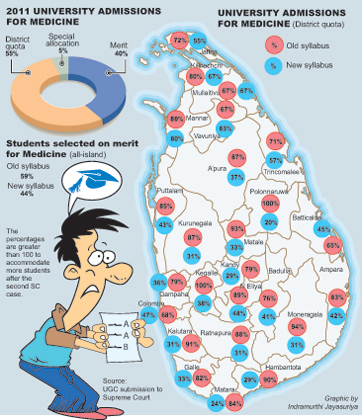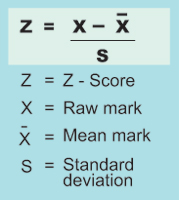News
Varsity hopefuls from 2012 A/L batch face uncertain future
View(s):By Kumudini Hettiarachchi and Shaveen Jeewandara
Has the University Grants Commission (UGC) made a mess of admissions to universities from the 2011 Advanced Level batch of students without considering the life and death consequences of its decision? Is it also attempting to surreptitiously foist the same fate on the 2012 A/L batch?

Students protesting over the z score muddle last year (file pic)
These are the serious concerns gripping both batches of students, while the UGC promised after a prolonged delay (1˝ years after the exam) to release the cut-off mark for university admissions of the 2011 batch this week. The Examinations Department has said that the 2012 A/L results would also be released this week.
Firstly issuing Z-scores and district rankings with computer errors and then coming out with a percentage-based (see graphic) university admission formula on “historical averages” for the 2011 A/L students (alleged by many to be “unfair”), the UGC seems to have got itself entangled in knots. Amidst the confusion, its Chairman Prof. Gamini Samaranayaka relinquishes duties on January 31.
Is there a change in the university admission policy without informing the public, is the serious concern that is not only keeping thousands of students on tenterhooks but also thousands of anxious parents worrying over the future of their children.
As the worry of “will we, won’t we” gain university admission grips the 2011 students, most 2012 A/L students are not even aware that newspaper advertisements on December 30, 2012 have placed them in the same plight even before the results have been released.
“From the moment the results of the 2011 A/Ls were released, it was a fiasco which has continued up to now,” said a parent from Kandy who declined to be identified.
“University admissions need to accommodate students who have earned their admissions by virtue of merit. The system needs to reward the students, not torture them like what is happening now,” Federation of University Teachers’ Associations Media Spokesperson Dr. Mahim Mendis said. “Giving fair justice to the students should be a priority, but it is undermined by the corrupt system”, he said.
Referring to the intricate lines that have been crossed by officials, he said there cannot be discrimination between two student populations. “Transparency in university admissions is the need of the hour,” Dr. Mendis said.
In 2011, 243,876 students sat the A/L examination, 144,341 under the new syllabus and 99,535 under the old.
The 2012 A/L examination was faced by 236,025 students under the new syllabus and 41,646 students under the old syllabus.
For Vihanga Kumarasinghe, 20, it is a time of despair. “I initially got an Z score of 1.91 which would get me into the engineering faculty, but when they changed it, my Z- score went down to 1.71 and that’s not enough,” he said.
“My initial Z-score was 1.993 and it was not enough to get me into Medical College. So I travelled to India to sit for a medical entrance exam,” says Chrishan Samarakoon, 21, a disgruntled student. “It was very strenuous and extremely competitive. Then I got my second Z-score which was 2.13 – which would get me into the medical faculty.”
Januka Silva, 22, an old-syllabus student, was of the view that they were at a disadvantage as their paper had an additional 10 questions. “I’m 22 and still stuck at home, while some of my friends who did their London A/Ls have gone abroad to study.”
“It’s been almost 18 months since the results came and no university entrance. I took up a junior post at the SMIB Bank and might continue there and forget about university,” said Hashantha Lekamge, 20, of Matara.
Dinesh Dimantha, 19, was adamant that the officials should not implement percentages. If they got the calculation right, then there is no need for a change in the Z-score mechanism.

The 2011 August examination results were released on December 25, the same year. Instead of calculating the Z-score in the manner in which it had been done since 2001, suddenly there was a change in the method, said the parent from Kandy, who along with numerous others has studied the issue.
There were two groups of students at the 2011 A/L: Those who had sat the old and new syllabi examinations separately. The new syllabus students knew that something was radically wrong when the grades they had secured at the examination were not reflected in their Z-scores, the parent said, speaking on behalf of many. “Their Z-scores were unbelievably low. To make matters worse, those students with low Z-scores were high up in the island ranking.”
In the first place, why had the UGC changed the method of calculating the Z-score in 2011, when in 2001 too there were two groups of students – those who sat for four subjects and others who sat for three, asked another perturbed parent. As the Z-score is a standardizing factor, what they did then was calculate the Z-scores of the two groups separately, based on their raw marks, and then bring both onto a common list.
“The Z-score of an individual student is calculated on his/her performance against his peers,” pointed out Prof. R.O. Thattil of the Department of Biostatistics of the Faculty of Agriculture, University of Peradeniya, who originally came up with the formula for the Z-score introduced in 2001 to equalise the disparities.
Now for the 2011 batch, percentages for university admissions have been worked out not on the ability of the students but on historical averages, a parent from Colombo lamented.
“This is not a representative sample of students eligible to enter the university. This gives an unfair advantage to the old syllabus students,” he said, explaining that unlike them, the new syllabus students were hamstrung with issues such as having no past papers or proper model papers, getting teachers’ guides late, amendments to the syllabi midway and being the guinea pigs for teachers who were trying out the new syllabus, etc.
Not only will the new syllabus students of 2011 be affected by this unjust and unfair scheme but it is also to be silently perpetuated on the 2012 new syllabus students, said many teachers that the Sunday Times spoke to.
The percentages based on historical values which was a settlement between the 2011 old syllabus students and the UGC before the Supreme Court, cannot be applied to any other batch, stressed several legal sources, adding that a new policy needs to be worked out for others as this applies only to the 2011 batch.
Thishakya Elakiwala, 19, who sat the A/L exam in 2012 has no faith in the system. “They messed up the Combined Maths paper of 2012 and they’re sure to mess up the Z-score as well. So I just finished my London exams, having paid a lot of money. It wouldn’t be the case if the authorities instilled faith in the students by doing their job right.”
The overall frustration and lack of faith in the system were clear as Selaka Hattotuwa, 19, stressed that “they should stick to the Z-score, but do it properly. Everybody’s fed up, they shouldn’t change the Z-score system.”
Prof. Thattil who explained the fundamentals of the Z-score system (see box), cautioned that “if you go by averages or percentages, the students are at a disadvantage”. With the Z-score system, there is no such injustice, as students are brought to a level playing field, not only with regard to the two syllabi but also the different combinations of subjects. In fact, the system proved vastly efficient up until the authorities got themselves into a “real pickle” in 2011, he added.
“It is common sense that a child sitting the exam for the first time has to be given more leverage than one who sits the second time around as the latter is equipped with prior experience,” he reiterates. “The current situation does not acknowledge this,” he said.
Alternatives and damage-control mechanisms proposed by Prof. Thattil have been disregarded by UGC officials, the Sunday Times understands.
The actual difference between the old and new syllabi material is not that much, although the question papers have a large disparity. The wisest choice would have been to set a common paper with some questions targeting the two groups separately, but this suggestion too was not heeded by the Examinations Department, Prof. Thattil said.
As the juggernaut rolls along, the officials are blindsiding the university admissions. The future of the students hoping to enter the local universities, the cream of the schoolchildren, is bleak, parents said, wondering aloud whether the UGC is promoting foreign education.
Whether it’s Z-score for district ranking or percentages for university admissions, there never will be a just system, said a voice of reason, adding, however, that the major flaw lies in the fact that there was no foresight and planning.
This is where the UGC has bungled and bungled very badly. It should have foreseen two populations sitting the examination in 2011 and announced a system way ahead, so that the students would have known in advance what to expect.
At least now, the UGC must think ahead about the 2013 batch, he urged, adding that both students and parents have lost faith in the system. The answer for the 2011 batch may be to maximize the numbers so that all those who had a “reasonable and justified” expectation of entering the university are accommodated.
The need now is to restore faith in the system quickly – but how the UGC will do it remains a deep mystery, he added.
Cut-off marks for 2011 A/L this week
The cut-off mark for the 2011 A/L will be released this week and a press conference held in this regard, was the only comment that Dr. M.M.P Premakumara, the UGC’s Additional Secretary of Academic Affairs and University Admissions Department made when contacted by the Sunday Times.
This was after numerous calls to both Prof. Samaranayake and Dr. Premakumara, all of which elicited no repsonse.
Refusing to comment on the mechanisms used in the calculation of the cut-off mark, Dr. Premakumara said that “percentages will come into effect”.
What is the Z-score and how it is calculated
The Z-score is calculated by subtracting the raw mark of the subject by the mean mark of the subject, and then dividing by the standard deviation of the marks of the subject. (see graphic).

The Z-score for a given subject is comparable to the Z-score of another subject, although raw marks cannot be compared, the Sunday Times learns.
Citing an example, Prof. Thattil said the raw mark of 50 for Physics may be an above-average mark, while for Geography it may even be below the average.
Although mean and variance of raw marks can differ from subject to subject, the Z-scores are distributed with a mean of zero and variance of 1, for any subject – effectively bringing all subjects to a common ground. Simply put, the marks of the subjects are thus standardised to make way for fair university admissions.
Chronology of events
- In 2001, when there are two student populations (those who had sat three and others four subjects), the Z-score system comes into effect for university admissions based on merit and district quota basis.
- In 2011, like in 2001, two student populations are there – those who did the ‘old’ and ‘new’ syllabi. Students not informed of any changes prior to the 2011 examination.
- The 2011 A/L results released on December 25, 2011.
- Re-issue of island ranks, due to error.
- Z-scores erroneously calculated after “pooling” raw marks of old and new syllabi students.
- Seven new-syllabus students appeal to the Supreme Court (SC).
- SC gives order on June 2012 that the two groups need to be considered as two student populations.
- The Committee chaired by the President’s Secretary Lalith Weeratunga, following the SC decision, recommends that the Z-score of the two student populations be calculated separately, then put together into one list and university admissions be made on a single cut-off mark.
- Old syllabus students go to the SC. Then UGC proposes four methods based on percentages for university admission on historical values. SC permits a settlement on September 12, 2012, allowing the third method which makes way for the most number of students to enter university. An intervention by the new syllabus students in September 2012 is rejected.
- The UGC publishes an advertisement in the newspaper on December 30, 2012, that the two populations and ‘percentage’ system based on historical values will be applied to the 2012 A/L students as well.
Follow @timesonlinelk
comments powered by Disqus















